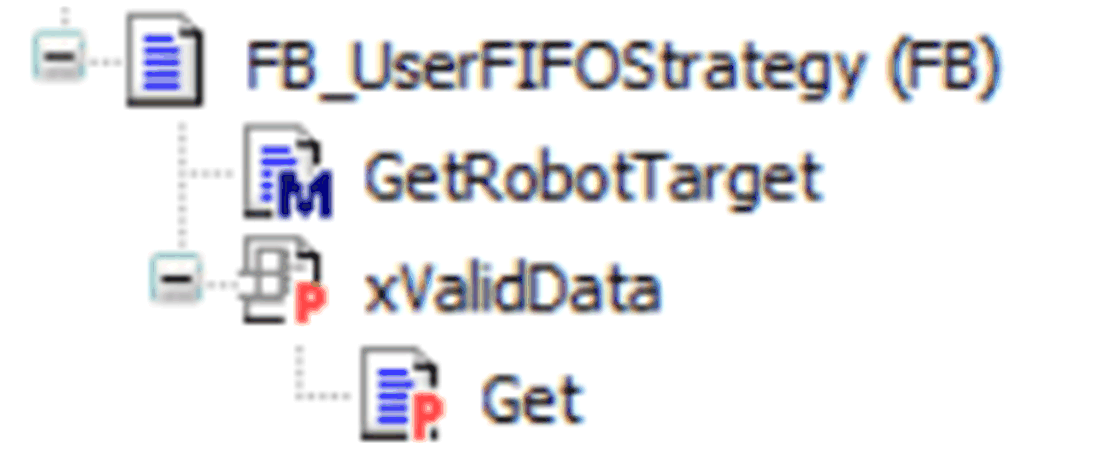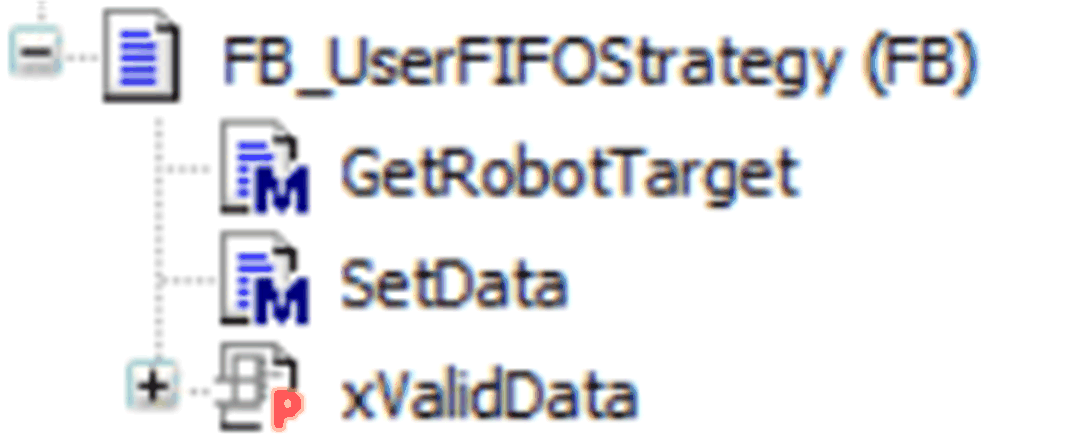Implementation Example of a FIFO Strategy
Overview
This example shows how you can implement a custom target selection strategy.
For this example it is assumed that:
-
The tracking direction is always set to ROB.ET_RobotComponent.CartesianX.
-
The Targets Handler on which the algorithm is applied does not contain slots.
Creation of the Target Selection Strategy Implementation
At first, you must create a new function block that implements the library interface IF_TargetSelectionStrategy. In this case, a function block named FB_UserFIFOStrategy is created.

Inside the interface of FB_UserFIFOStrategy, a new internal variable called _xValidData of type BOOL was defined. This is used as return value for the interface property xValidData.
FUNCTION_BLOCK FB_UserFIFOStrategy IMPLEMENTS SERT.IF_TargetSelectionStrategy
VAR
_xValidData : BOOL;
END_VARThe underscore in front of the variable name is just a naming convention to identify the internal variables of the function block.
It is also possible to add an implementation for the method of the property xValidData.
xValidData := _xValidData;
Adding a Configuration Method
The interface IF_TargetSelectionStrategy does not contain any configuration method and you have to create an own method for this purpose.

In this case, it has been defined a method called SetData with the following interface:
VAR_INPUT
i_ifTargetsHandler : SERT.IF_TargetsHandler;
i_stTrackingConstraints : SERT.ST_TrackingConstraints;
END_VARMoreover, two internal variables are added to the function block since they are required to store the values passed through the SetData method.
FUNCTION_BLOCK FB_UserFIFOStrategy IMPLEMENTS SERT.IF_TargetSelectionStrategy
VAR
_xValidData : BOOL;
_ifTargetsHandler : SERT.IF_TargetsHandler;
_stTrackingConstraints : SERT.ST_TrackingConstraints;
END_VARThe body of the SetData method can be implemented as it follows:
//clean the flag
_xValidData := FALSE;
//check that i_ifTargetsHandler contains a valid interface,
//otherwise return
IF i_ifTargetsHandler = 0 THEN
//add some diagnostics here
RETURN;
END_IF
//store the values inside the internal variables
_ifTargetsHandler := i_ifTargetsHandler;
_stTrackingConstraints := i_stTrackingConstraints;
//set the flag
_xValidData := TRUE;Implementing GetRobotTarget
In this case, it is required to implement a FIFO strategy. The algorithm searches for the target with the greatest position along the tracking direction and within a working area described by the tracking constraints.
It is required to define some additional variables used inside the GetRobotTarget method first:
METHOD GetRobotTarget : SERT.ST_RobotTarget
VAR_INPUT
i_etRobotId : SERT.ET_SystemEntity;
END_VAR
VAR_OUTPUT
q_etDiag : GD.ET_Diag := GD.ET_Diag.Ok;
q_etDiagExt : SERT.ET_DiagExt := SERT.ET_DiagExt.Ok;
q_sMsg : STRING(80);
END_VAR
VAR
udiIndex : UDINT;
stTempTarget : SERT.ST_RobotTarget;
END_VARThe following code is added to the body of the method:
IF NOT _xValidData THEN
//add diagnostics here
RETURN;
END_IF
//get the first index in the list
udiIndex := _ifTargetsHandler.udiFirstListIndex;
WHILE udiIndex <> SERT.Gc_udiTailListIndex DO
//get the target in the list at index udiIndex
stTempTarget := _ifTargetsHandler.GetTarget(
i_udiListIndex := udiIndex,
q_etDiag => q_etDiag,
q_etDiagExt => q_etDiagExt,
q_sMsg => q_sMsg
);
//there was an error while getting a target
IF q_etDiag <> GD.ET_Diag.Ok THEN
RETURN;
END_IF
//check if the target is inside the working area, if yes,
//the search ends here
IF stTempTarget.stCurrentPose.stPosition.lrX >= _stTrackingConstraints.stMinPosition.lrX AND stTempTarget.stCurrentPose.stPosition.lrX <= _stTrackingConstraints.stMaxPosition.lrX THEN
//return the current target as the selected one
GetRobotTarget := stTempTarget;
RETURN;
END_IF
//get the next index in the list
udiIndex := _ifTargetsHandler.GetNextListIndex(
i_udiListIndex := udiIndex,
q_etDiag => q_etDiag,
q_etDiagExt => q_etDiagExt,
q_sMsg => q_sMsg
);
//there was an error while getting the next list index
IF q_etDiag <> GD.ET_Diag.Ok THEN
RETURN;
END_IF
END_WHILEDescription of the code content:
-
Verify that the internal data is valid, otherwise return.
-
Get the first index in the list in the targets handler; since the targets inside the targets handler are sorted in descending order, the first element of the list has always the greatest position along the tracking direction (positive X direction in this case).
-
For each index, get the relative ST_RobotTarget in the list and verify if its position is within the minimum and maximum positions defined inside the tracking constraints.
-
Since the elements in the list are in descending order, as soon as a target inside the working area is found, the algorithm can return.
-
If the present target is not valid, the algorithm gets the next target index from the targets handler and proceeds with the next cycle.